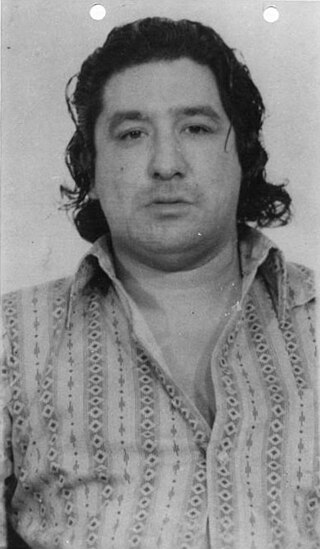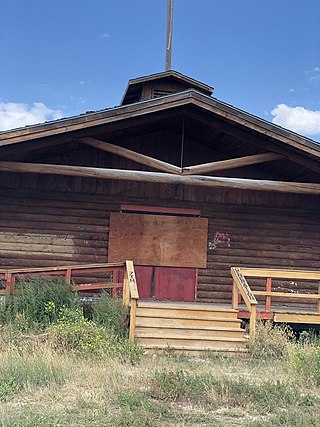
Leonard Peltier is a Native American activist and a member of the American Indian Movement (AIM) who, following a controversial trial, was convicted of two counts of first degree murder in the deaths of two Federal Bureau of Investigation (FBI) agents in a June 26, 1975, shooting on the Pine Ridge Indian Reservation in South Dakota. He was sentenced to two consecutive terms of life imprisonment and has been imprisoned since 1976. Peltier became eligible for parole in 1993. As of 2022, Peltier is incarcerated at the United States Penitentiary, Coleman, in Florida.

The American Indian Movement (AIM) is an American Indian grassroots movement which was founded in Minneapolis, Minnesota in July 1968, initially centered in urban areas in order to address systemic issues of poverty, discrimination, and police brutality against American Indians. AIM soon widened its focus from urban issues to many Indigenous Tribal issues that American Indian groups have faced due to settler colonialism in the Americas. These issues have included treaty rights, high rates of unemployment, the lack of American Indian subjects in education, and the preservation of Indigenous cultures.

John Trudell was a Native American author, poet, actor, musician, and political activist. He was the spokesperson for the Indians of All Tribes' takeover of Alcatraz beginning in 1969, broadcasting as Radio Free Alcatraz. During most of the 1970s, he served as the chairman of the American Indian Movement, based in Minneapolis, Minnesota.
News From Indian Country was a privately owned newspaper, published once a month in the United States, founded by the journalist Paul DeMain (Ojibwe/Oneida) in 1986, who served as a managing editor and an owner. It was the oldest continuing, nationally distributed publication that was not owned by a tribal government. It offered national, cultural and regional sections, and "the most up-to-date pow-wow directory in the United States and Canada," according to its website. The newspaper was offered both in print and electronic form and has subscribers throughout the United States, Canada and 17 other countries.

Russell Charles Means was an Oglala Lakota activist for the rights of American Indians and all oppressed First Nation Americans, libertarian political activist, actor, musician and writer. He became a prominent member of the American Indian Movement (AIM) after joining the organization in 1968 and helped organize notable events that attracted national and international media coverage.

Dennis Banks was a Native American activist, teacher, and author. He was a longtime leader of the American Indian Movement, which he co-founded in Minneapolis, Minnesota in 1968 to represent urban Indians. He was a pre-eminent spokesman for Native Americans. His protests won government concessions and created national attention and sympathy for the oppression and deplorable endemic social and economic conditions for Native Americans.
The American Indian Movement of Colorado, also called AIM-International Confederation of Autonomous Chapters, is a breakaway group from the American Indian Movement.

Annie Mae Aquash was a First Nations activist and Mi'kmaq tribal member from Nova Scotia, Canada. Aquash moved to Boston in the 1960s and joined other First Nations and Indigenous Americans focused on education and resistance, and police brutality against urban Indigenous peoples. She was part of the American Indian Movement, participated in several occupations, and participated in the 1973 Wounded Knee incident at the Pine Ridge Indian Reservation, United States.

Thunderheart is a 1992 American Neo-Western mystery film directed by Michael Apted from a screenplay by John Fusco. The film is a loosely based fictional portrayal of events relating to the Wounded Knee incident in 1973, when followers of the American Indian Movement seized the South Dakota town of Wounded Knee in protest against federal government policy regarding Native Americans. Incorporated in the plot is the character of Ray Levoi, played by actor Val Kilmer, as an FBI agent with Sioux heritage investigating a homicide on a Native American reservation. Sam Shepard, Graham Greene, Fred Ward and Sheila Tousey star in principal supporting roles. Also in 1992, Apted had previously directed a documentary surrounding a Native American activist episode involving the murder of FBI agents titled Incident at Oglala. The documentary depicts the indictment of activist Leonard Peltier during a 1975 shootout on the Pine Ridge Indian Reservation.

The Wounded Knee Occupation, also known as Second Wounded Knee, began on February 27, 1973, when approximately 200 Oglala Lakota and followers of the American Indian Movement (AIM) seized and occupied the town of Wounded Knee, South Dakota, United States, on the Pine Ridge Indian Reservation. The protest followed the failure of an effort of the Oglala Sioux Civil Rights Organization (OSCRO) to use impeachment to remove tribal president Richard Wilson, whom they accused of corruption and abuse of opponents. Additionally, protesters criticized the United States government's failure to fulfill treaties with Native American people and demanded the reopening of treaty negotiations to hopefully arrive at fair and equitable treatment of Native Americans.

Incident at Oglala is a 1992 American documentary film directed by Michael Apted and narrated by Robert Redford. The film documents the deaths of two Federal Bureau of Investigation agents, Jack R. Coler and Ronald A. Williams, on the Pine Ridge Indian Reservation on June 26, 1975. Also killed in the multiple fire was Native American Joe Stuntz, a member of the American Indian Movement (AIM), whose death prompted no legal action.
Perry Ray Robinson was an African American activist from Alabama during the civil rights movement. He had been active in Mississippi and Washington, D.C., supporting the March on Washington and the Poor People's Campaign. Robinson disappeared while participating in the 1973 American Indian Movement (AIM) resistance in the Wounded Knee incident on the Pine Ridge Indian Reservation in South Dakota.
Lorelei DeCora Means is a Native American nurse and civil rights activist. She is best known for her role in the second siege in the town of Wounded Knee, South Dakota, on the Pine Ridge Indian Reservation. She was also a co-founder of the American Indian organization, Women of All Red Nations.
Edgar Donroy Bear Runner was a Native American activist. He is perhaps best known for attempting to peacefully negotiate the Jumping Bull ranch incident in 1975 via parleying with American Indian Movement activists.
Frank Blackhorse is one of several aliases used by a member of the American Indian Movement. He is perhaps best known for his participation in the Wounded Knee incident, particularly his role in the shootout that left two FBI and one American Indian dead and for becoming a fugitive on the run who fled to Canada shortly after.
Darlene Nichols, also known by the names Kamook, Ka-Mook, Kamook Nichols and Ka-Mook Nichols, is the name of a former AIM member and Native American protester. She is best known for her role in the American Indian Movement for organizing The Longest Walk, and for serving as a key material witness in the trials of Arlo Looking Cloud, Richard Marshall, and John Graham that ultimately led to the conviction of two AIM members in the murders of Anna Mae Aquash.
Arlo Looking Cloud is a former Native American activist. He is perhaps best known for his involvement with the murder of fellow American Indian Movement activist Anna Mae Aquash.
John Graham is a Canadian, Yukoner, Champagne and Aishihik First Nations citizen, and former Native American activist. He is best known for being convicted for the murder of fellow American Indian Movement activist Anna Mae Aquash.
Theda Nelson Clarke, born Theda Rose Nelson (1924-2011), was a Native American activist. She is perhaps best known for her involvement in the Wounded Knee incident with the murder of fellow American Indian Movement activist Anna Mae Aquash.
Thelma Conroy-Rios was a Native American activist. She is perhaps best known for her involvement in the Wounded Knee incident and for her involvement in the murder of fellow American Indian Movement activist Anna Mae Aquash.








